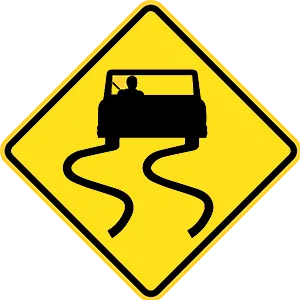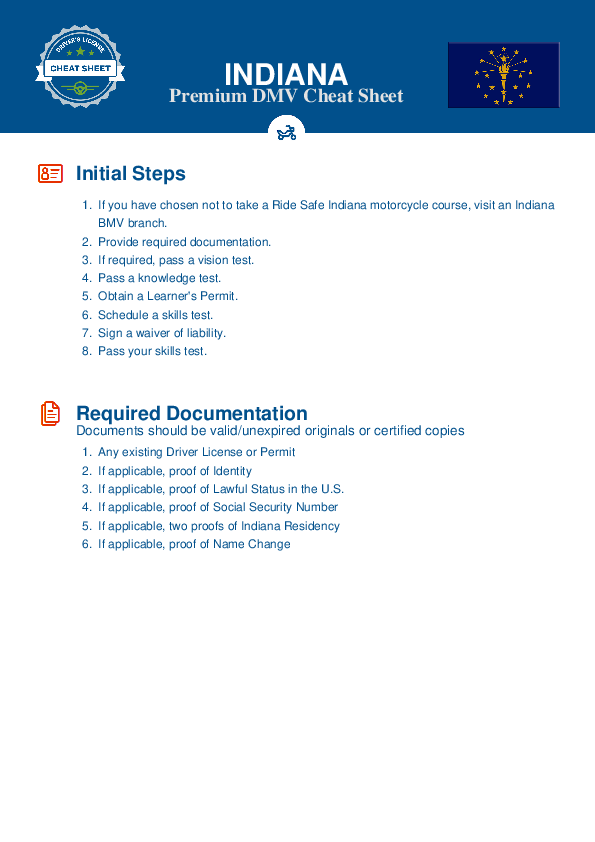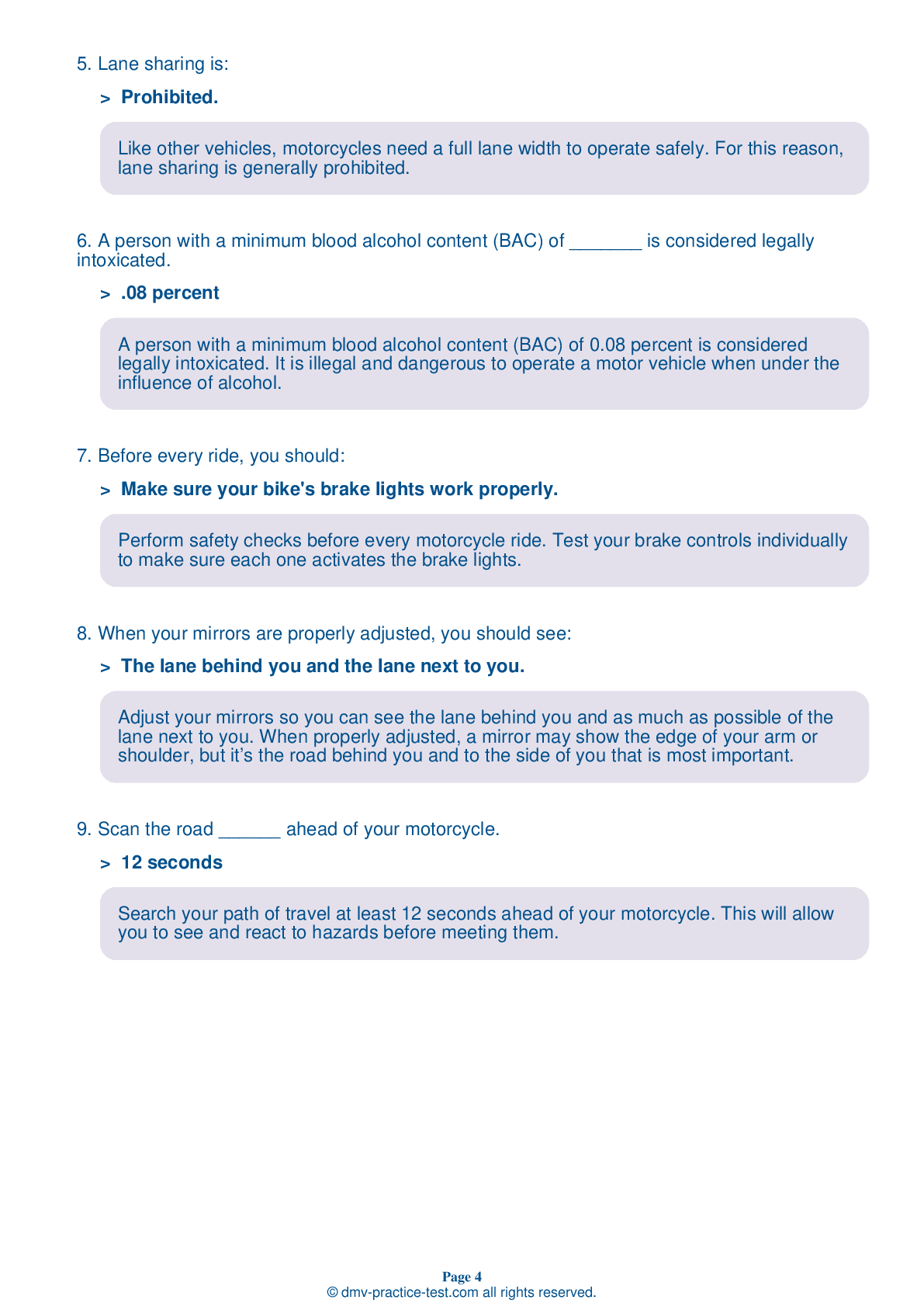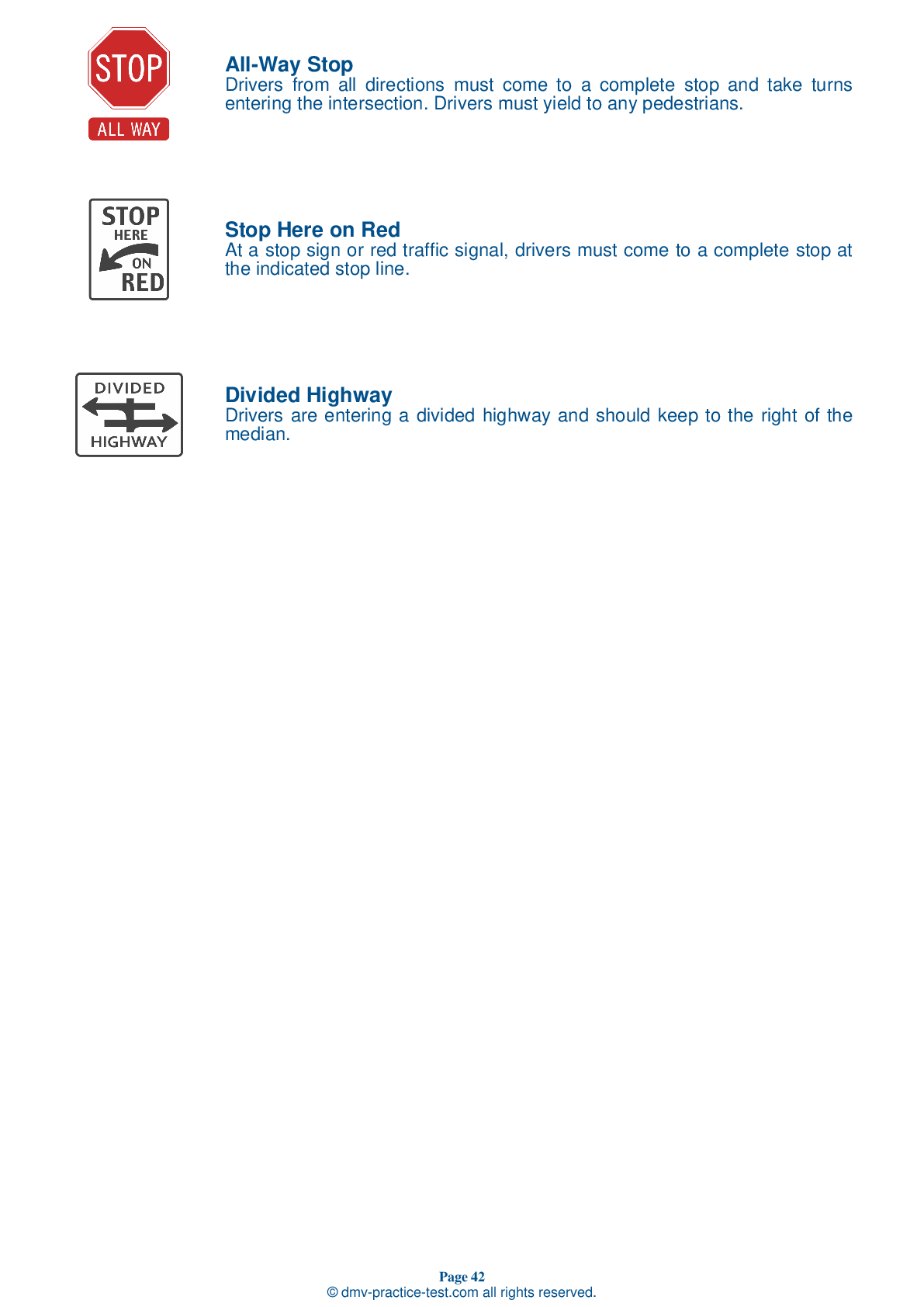DMV Permit Test #11
Motorcycle Test | License IN 2025 | FREE Online Practice! #11 Page 4 of 4
Take this FREE motorcycle test (license in IN 2025) to check your knowledge of the road rules. To improve your results, download a motorcycle handbook online, study theory, and practice for free on our website. Still worried about how to get a motorcycle license in Indiana in 2025? Check our website for more sample tests, train as much as possible, and boost your grades!
25
21
16
19 . Which of the following is true?
Only the front brake should be used when braking.
The front brake of a motorcycle is more powerful than the rear one, providing at least 70 percent of the total stopping power. Always use both brakes any time you slow or stop.
20 . If you are riding over rain grooves or bridge gratings and your motorcycle begins to weave, you should:
Move to the leftmost portion of the lane.
A motorcycle may weave while riding over rain grooves or bridge gratings, but this is generally not dangerous. If your motorcycle begins to weave, simply relax and proceed straight ahead at a steady speed. Trying to ride in a zigzag pattern to compensate for the weave will only increase the hazard.
21 . More than half of all crashes:
Involve riders who have little experience on their motorcycles.
Most motorcycle crashes involve riders with little experience on their motorcycle.
22 . This sign means:

Roadwork ahead.
Warning signs prepare drivers for upcoming road conditions and hazards and are usually yellow with black markings. This sign tells drivers to be cautious when driving under conditions that may cause the roadway to become wet and slippery.
23 . When gripping the handgrips, your hands should:
Feel relaxed and free.
Adjust the handlebars so your hands are even with or below your elbows. This positioning allows you to use the proper muscles for precision steering.
24 . When following a car, usually the best portion of the lane to ride in is:
The left or right portions.
When riding behind a passenger vehicle, it is usually best to ride in the center of the lane so you will be visible in the driver's rearview mirror. Most drivers check their rearview mirrors much more often than their side mirrors, so this lane position will increase your chances of being seen.
25 . When passing, you:
May ride 15 mph above the maximum speed limit.
Passing must be completed within posted speed limits. Only pass another vehicle where it is safe and legal to do so.
2025 Indiana | Frequently Asked Questions
To acquire a motorcycle license in Indiana, you must first hold a valid Indiana driver's license. Then, you'll need to pass a written motorcycle knowledge exam and a motorcycle skills exam. Alternatively, you can complete a state-approved motorcycle safety course which often waives the skills test requirement. You must also pay the necessary fees to receive your motorcycle endorsement.
In Indiana, the minimum age to obtain a motorcycle driver's license is 16 years and 90 days. However, before getting a full endorsement, riders under the age of 18 must hold a valid motorcycle learner's permit for at least 30 days and must successfully complete a state-approved motorcycle safety course.
Yes, you do need a dedicated license for motorcycle riding in Indiana. This is known as a motorcycle endorsement and it is added to your regular driver's license. To obtain this endorsement, you must pass a written test and a riding skills test. Alternatively, completion of an approved motorcycle safety course can waive these testing requirements.
To apply for a motorcycle driver's license in Indiana, you'll need the following documents: proof of identity (like a birth certificate or passport), proof of Social Security number, proof of lawful status in the U.S., and two proofs of Indiana residency. If you're under 18, you'll also need a legal guardian's consent and proof of enrollment in school.
Yes, you will need to take a written exam to get a motorcycle license in Indiana. The exam covers topics such as traffic laws, road signs, and safe riding techniques. However, if you successfully complete an approved motorcycle rider education course, the written and skills tests may be waived.
The motorcycle written test in Indiana covers various subjects related to motorcycle safety and operation. Topics include traffic laws, road signs, safe riding techniques, handling dangerous situations, and motorcycle maintenance. The test also covers protective gear, passenger rules, and alcohol/drug effects on riding. Studying the Indiana Motorcycle Operator Manual is recommended to prepare for the test.
Yes, in Indiana, completing a state-approved motorcycle safety course can substitute for the written and skills tests required for a motorcycle endorsement. The course includes classroom instruction and hands-on training. Upon successful completion, you'll receive a waiver for the BMV tests. However, you still need to apply in-person at a BMV branch to add the endorsement to your license.
To enroll in a motorcycle training course in Indiana, first, find a state-approved course provider. Then, sign up either online or by phone. Courses usually require payment upfront. You'll need a valid driver's license or learner's permit. Some courses provide motorcycles and helmets, but check with the provider. Once enrolled, attend all sessions and successfully complete the course to receive certification.
No, you do not need to own a motorcycle to take the license test in Indiana. You can use a borrowed motorcycle, as long as it is street-legal, properly insured and registered. However, the motorcycle must be appropriate for your size and skill level. Remember to bring a helmet and eye protection for the test.
Yes, you can use a friend's motorcycle for your driver's license evaluation in Indiana, provided the motorcycle is street-legal, registered, insured, and you have permission to use it. It must also meet all safety requirements and be appropriate for your size and skill level. You'll also need a helmet and protective eyewear.
Yes, in Indiana, the motorcycle driving exam tests specific handling skills. These include left and right turns, swerving, quick stops, cone weaving, and U-turns. The test evaluates the rider's ability to control the motorcycle, make safe riding decisions, and apply Indiana's traffic laws. The skills test is designed to ensure motorcyclists can operate their vehicles safely on the road.
Yes, in Indiana, new motorcycle drivers under the age of 18 must first obtain a motorcycle learner's permit. This permit has restrictions such as no nighttime riding, no passengers, and no interstate riding. After 30 days of maintaining a learner's permit, they can apply for a motorcycle endorsement or license.
Yes, your Indiana driver's license with a motorcycle endorsement allows you to operate a motorcycle in other states. However, it's important to note that you must abide by the traffic laws of the state you are in, which may differ from those in Indiana. Always check local laws when traveling out of state.
In Indiana, state law requires all motorcycle riders under the age of 18 to wear a helmet and eye protection. However, riders aged 18 and over are not legally required to wear a helmet. Despite this, it's highly recommended for all riders to wear a helmet for their safety, as it greatly reduces the risk of head injuries.
Yes, Indiana offers two types of motorcycle licenses: a motorcycle-only license and a motorcycle endorsement. The motorcycle-only license allows you to only operate a motorcycle, while the motorcycle endorsement can be added to a valid Indiana driver's license, permitting you to operate both a motor vehicle and a motorcycle.
Yes, you can add supplementary endorsements to your motorcycle license in Indiana. These endorsements allow you to operate different types of motorcycles. However, each endorsement may require additional testing. It's recommended to check with the Indiana Bureau of Motor Vehicles for specific requirements related to the endorsement you want to add.
Yes, in Indiana, the motorcycle written test is available in several languages other than English. This is to accommodate a diverse range of applicants. However, it's advisable to contact your local BMV branch beforehand to confirm the availability of the test in your preferred language.
An effective strategy to prepare for the motorcycle license test in Indiana is to study the Motorcycle Operator Manual, which is available online or at any BMV branch. The manual covers all the information you need. Also, taking online practice tests can be beneficial as they familiarize you with the format and type of questions on the actual test. Remember to get enough rest before your test day.
Yes, the motorcycle written exam in Indiana can be taken in several languages other than English. The Bureau of Motor Vehicles (BMV) offers the exam in 14 different languages. However, it's recommended to contact your local BMV branch ahead of time to ensure your preferred language is available.
Yes, retaking is allowed if you don't pass the motorcycle written test in Indiana. After failing, you need to wait at least one day before retaking the test. However, if you fail the test three times, you must wait two months from the date of the last failed test before attempting again. It's advisable to study thoroughly to improve your chances of passing.



